With the Indian Air Force (IAF) making it clear that it is looking for a homegrown solution for its fifth generation fighter aircraft (FGFA) requirement, the Aeronautical Development Agency’s (ADA’s) Advanced Medium Combat Aircraft (AMCA) project seems ready to shift to a higher gear. To be sure, ADA, which is controlled by the Defence Research & Development Organization (DRDO), has already made considerable progress towards finalizing the AMCA design configuration that will be taken up for full-scale engineering development (FSED). Much work has also been done towards the development of technologies and systems relevant to the AMCA’s design elements. As such, ADA expects to receive a preliminary staff qualitative requirement (PSQR) from the IAF in the coming weeks, which will serve to further inform the development of two AMCA technology demonstrators (AMCA-TDs).
The Expression of Interest (EOI) to build the two TDs was floated back in 2018 itself and has received responses from several domestic firms. However, given that no single player in the domestic private sector can build such a complex system on its own, a consortium approach involving multiple players is likely to be adopted for the construction of these TDs. In a way, it will be a natural outgrowth of the manner in which major sub-assemblies for the Hindustan Aeronautics Limited (HAL) Tejas Mk1 has been outsourced to multiple companies, with integration, checkout and delivery being done by HAL. Overall, a decision with respect to precisely where the two TDs will be built is expected to be taken up within the next six months at the level of the Defence Minister. Be that as it may, both TDs will be ‘full-scope’ demonstrators in keeping with the IAF’s requirements and will be used to test the entire intended flight envelope for the baseline AMCA airframe design. This last part is subject to the availability of higher thrust engines in the future, as we shall see below.
Latest design developments
The AMCA has been designed to be a ‘true’ multi-role twin-engine FGFA with the usual roster of capabilities associated with the same, such as sensor fusion, stealth, supermaneuverability and supercruise (with suitable engines). According to ADA, it will have a max take-off weight (MTOW) of around 25 tons, while being able to carry a maximum of 6.5 tons of fuel internally. Additional fuel for missions may be carried not only in drop tanks hanging from certain underwing stations but also in specially-designed detachable fuel tanks compatible with the AMCA’s internal weapons bay (IWB). Meanwhile, modifications to a range of weapons that will make them suitable for IWB carriage are currently under study. Such modifications would include, for example, the use of folding fins on air to air missiles and glide bombs. Design of ‘eject launchers’ for the IWB is also underway. This ability to carry a mix of fuel and munitions in the IWB will enhance flexibility for both missions where stealth is a priority, as well as where it is not.

Image: AMCA Internal Weapons Bay
The two AMCA-TDs will also feature diverterless supersonic inlets (DSIs) instead of the intakes featured in mockups displayed till date. Design work on DSI is complete and this has apparently resulted in a significant reduction in the overall radar cross-section (RCS) of the baseline AMCA airframe design. As far as flush air data sensors are concerned, ADA’s work on this has grown out of its contribution to ISRO’s Re-Entry Launch Vehicle TD (RLV-TD) project. However, while the RLV-TD flies a predictable and pre-determined path, the flight envelope for the AMCA will be far more complex and a significant amount of work is being put in to achieve flush air data sensing system (FADS) hardware to cater to the same. As of now, a centerline fuel tank carried by a prototype from the LCA family has been modified and fitted with AMCA FADS hardware for the purpose of developmental testing. Interestingly, some developments from the AMCA effort are also finding their way back to the MWF project and even HAL’s Tejas Mk1A programme.
The AMCA baseline design will be developed into two versions suitable for production, namely MkI and MkII. The AMCA MkI configuration will be equipped with an off-the-shelf engine such as the General Electric F414 INS6 which has already been chosen to power the Tejas Mk2 Medium Weight Fighter (MWF). Although, the AMCA baseline airframe has been designed to be powered by a larger engine producing greater thrust, suitable modifications have already been identified that will allow the AMCA-TDs to incorporate, say, the F414 INS6 instead. This in turn will allow the development of the AMCA MkI configuration to be progressed even as India goes about acquiring/developing a new engine that will allow the AMCA baseline design to achieve its true potential, as it were. In any case, the first AMCA-TD is expected to fly by the fiscal year 2024-25, with the AMCA Mk1 configuration projected to enter series production by 2029-30. The IAF has committed to acquiring a couple of squadrons of the AMCA MkI but is naturally looking forward to the MkII to provide it with a major edge on the Eastern front.
Spiral Development and the AMCA MkII
The AMCA MkII is expected to be produced in greater numbers than the MkI and will be equipped with new engines in the 110 Kilonewton (KN) class that will allow the entire performance envelope of the AMCA baseline design to be achieved. For instance, the AMCA baseline airframe will not be able to supercruise with F414 INS6 engines. The IAF desires supercruise capability from its FGFA at a certain altitude and that can only be achieved with a higher thrust engine.
At the moment, however, there is no suitable commercially available engine that meets the performance requirements of the AMCA MkII configuration. Of course, multiple foreign original equipment makers (OEMs) have made offers to DRDO to co-develop such an engine in response to a request for information (RFI), but the matter is not settled, so to speak. The idea is for DRDO’s Gas Turbine Research Establishment (GTRE) to enter into a joint-venture with a foreign engine OEM to ‘co-develop’ & ‘co-produce’ the desired engine. Unfortunately, even if the issue were to be decided today, this effort would yield a suitable engine only by the early 2030s. Nevertheless, this engine will be designed to be a ‘drop-in’ replacement (in terms of compatibility with connectors etc.) for whatever is used initially on the AMCA-TDs. It is not entirely clear at the moment, whether more TDs will be built in the future to serve the developmental needs of the AMCA MkII configuration.
After all, the AMCA MkII will not merely be the AMCA MkI with a new engine. Certain ‘sixth generation’ characteristics such as the ability to be optionally manned are being envisaged by ADA for the AMCA MkII. Incidentally, automatic take-off and landing (ATOL) capability, which is a key requirement if the AMCA MkII has to be optionally manned, will be initially tested on an LCA-Navy prototype.
ATOL is, obviously, also a crucial capability for the ‘Ghatak’ single-engined unmanned combat aerial vehicle (UCAV) that is currently under development with DRDO’s Aeronautical Development Establishment (ADE). This UCAV, with a currently projected MTOW of around 13 tons, will have a wingspan greater than that of the Tejas Mk1. It will be powered by a non-afterburning turbofan developed from the core of the Kaveri jet engine and an initial sum of Rs 500 crores has been sanctioned for this purpose. ADA says that both the IAF and the Indian Navy have expressed great interest in the Ghatak. The IN, in particular, is desirous of acquiring a carrier capable version that can fly as an unmanned ‘wingman’ with its next generation carrier-based fighter slated to be developed under the Twin-Engine Deck Based Fighter (TEDBF) programme. But that is a story for another day.
Saurav Jha is the Editor-in-Chief of Delhi Defence Review. Follow him on twitter @SJha1618
© Delhi Defence Review. Reproducing this content in full without permission is prohibited.
































